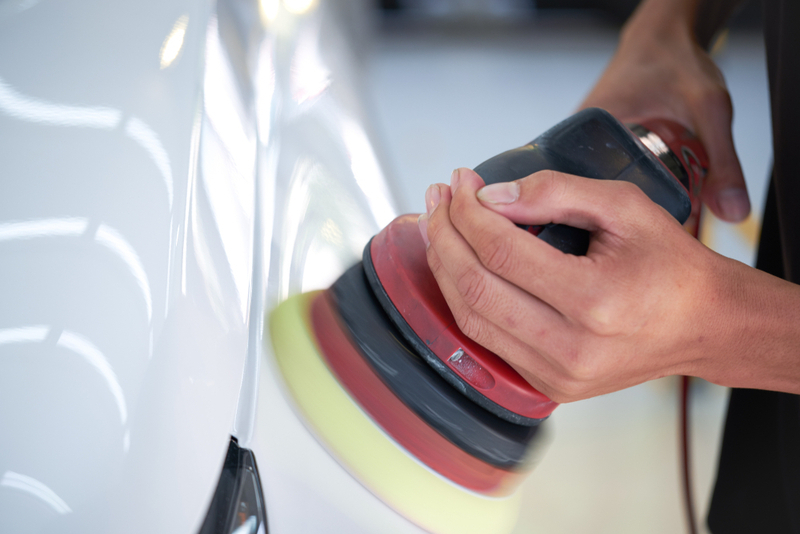Polishers have existed for a long time; however, modern polishing machines are built with great features and designs that make polishing activities easy. These designs include forced rotation, dual action, rotary, and random orbital.
Each of the designs of these polishing machines describes their unique working principle; however, each has the advantages and disadvantages of different working scenarios.
This article will treat the Random Orbit vs. Dual Action debate, describing how these polishers work, and your pros and cons for tasks requiring polishing.
Let’s get started!
What is the Difference Between Random Orbit and Dual Action
This differs from a random orbit polisher in that the rotating and orbiting motions are both driven by forced rotation. Random orbits use momentum to spin the pad and solely drive the orbit. These devices compel rotation and orbit.
The different types of polisher designs are practically named after the movement pattern; therefore, you must understand the terminologies used to describe these movement patterns to understand how these Polishers work fully.
Here is a clearer view of how each of these polishers works;
To make things more clear, let’s break down the terms used to describe polisher variants:
- Orbital – A terminology that describes an elliptical movement centered around a specific position.
- Rotational – The rotational terminology describes a circular movement around a specific position.
- Dual action – The dual action technology describes the combination of rotational and orbital movement.
- Random – The random terminology describes movement in an undefined zigzag manner over a plain surface.
- Forced Rotation – The forced rotation terminology describes the addition of more pressure on a surface irrespective of the movement pattern that the Polisher uses.
With a breakdown of these terminologies, it will be easier to understand how polishers work and where best to use them.
Also Read: Problems After Using Cataclean (What to Expect)
Random Orbit vs Dual Action: Key Differences
As mentioned earlier, there are three main polishers designs, and among them, the simplest is the rotatory polisher, popularly known as rotational Polishers.
The rotational polishers work in a simple and easy-to-use way. The polishing pad is designed to rotate like an angle grinder. The rotational pattern of this pollution bowls in One direction, anti-clockwise or clockwise, and continues until you are done polishing.
The random orbital Polisher is a more slow-paced polisher whose Polisher is in a pattern that depicts elliptical shapes randomly hugging different points. Sometimes people refer to the random orbital Polisher and non-rotating Polishers because it has a very low RPM and makes mini orbits around the lug in the polisher.
From the description of a dual-action polisher, you will understand that it combines the strengths of rotational and orbital movements. Dual action polishers have a fixed center point that acts as a center for the elliptical orbits and the circular rotations of the polishing pad; therefore, the polishing pad does not move randomly; however, it can polisher wide surfaces effectively due to its surface coverage.

What is Rotational Polisher
The rotational Polisher is one of the very first types of polishers to be manufactured; however, since the introduction of dual action polishers, the use of rotational Polishers has reduced drastically, although rotational Polishers are still the cheapest on the market.
There are many reasons why most users are deterred from using rotational Polishers, and some of them include the unwanted creation of buffer marks on the surface on which it is used.
Not just anyone can use a rotational Polisher and obtain a great result. This statement might shock most people, but you must be skilled to use the rotational Polishers.
A skilled user will save energy and clear coat because rotational Polishers are light and easy to carry and do not use a white cross-sectional area of clear coat to work.
There are many activities that professionals prefer using rotational Polishers; for example, rotational polishers will give you a better surface finish during Polishing and waxing activities; although it might leave some buffer marks, the luster obtained is outstanding.
The random orbital Polisher is another great design that rotates in a way that seems to create the circumference of an imperfect ellipse.
This Polisher design does not give its user the best shiny finish; however, it is very useful for applying wax and light surface Polishing. The random orbital Polisher can be described as a kind of dual-action Polisher.
A great attribute of using these types of polishers is that you do not necessarily need to be greatly skilled as the Polishers are commented with many mechanics and are suitable for unskilled or novice users.
Nevertheless, professionals will get much work done quickly using these Polishers.
What is the Best Polishers
Using a rotational, random orbit, or dual action Polisher, we’ll give you similar results; however, the quality of the results you get depends on the quality of the products you use. For this reason, here at the best rotational, random orbit, and action polisher;
Rupes: The Rupes Polisher is a great and unique product, as professionals mostly use it. This Polisher can be described as a dual action or random orbital Polisher.
SPTA: SPTA is another wonderful Polisher that runs on a 1,200-watt system and has a budget-friendly price tag. This Polisher is also rotational; however, it has a versatile speed option between 500 to 3,500 RPM and numerous spare parts.
Dewalt Polisher: The Dewalt Polisher is a very popular rotational Polisher on the market, although it is fairly expensive. This rotational Polisher weighs only 6.7 pounds and runs on a 12 amp motor and a max power of 1250.
This Polisher also offers great control, although it has a maximum speed of around 3,500 RPM. But you must still understand that as a rotational Polisher, it will leave little buffer marks.
TORQX: The TORQX is one of the few Polishers on the market that is an orbital Polisher. This Polisher does not consume much power; although expensive, it is great for doing light touch-ups on your replying wax on various surfaces.
Makita: Makita is also one of the best dual-action Polishers on the market currently.
ENEARCO: ENEARCO is another rotational Polisher that offers great features with a cheaper affordability rate. This product runs on a 1,200-watt system with a speed range of 1500 to 3500 r p m.
This product is an excellent alternative to the Dewalt Polisher.
In addition to its wonderful features, it has great aesthetics and numerous spare pads.
Advantages and Disadvantages of Random Orbit Polishers
Pros
- Ease of use
- Easily Affordable
Cons
- Low durability when compared to rotational Polishers

Merits and Demerits of Dual-Action Orbital Polishers
Pros
- Safe for beginners yet stronger than a random orbit Polisher
Cons
- Limited backing plate options.
- Low Polishing capacity due to a fixed rotation
People Who Should Use Random Orbit Polishers and Dual Action Polishers
- Novice
- Safety-conscious people
- DIY enthusiasts
- People are going into a part-time or full-time detailing business.
- People who want to add a DA Polisher to their business tools.
- Body shop workers aim to get a swirl-free finish.
- Boatowner wishing to maintain their boat
- RV owners wishing to maintain their RV
Also Read: Wheel Rust Remover (Everything to Know)
Frequently Asked Questions – Random Orbit vs. Dual Action
Is dual action better?
Using a dual-action Polisher is a great option that produces a higher-quality finish.
Can a random orbital sander be used as a Polisher?
It is possible to use a random orbital sander as a Polisher.
Can you buff with a dual-action Polisher?
Dual action polishers are great for Buffing out light scratches from cars using the clear coat.
Conclusion – Random Orbit vs. Dual Action
Irrespective of the polisher design you use for polishing, you are bound to get a good result; however, do you know there are various working principles? The results may vary slightly. The major difference between the dual action polisher sander random orbital Polisher is that the random orbital polisher is less effective for Polishing purposes but I rather perfect for applying wax or performing light surface polishing.

